Export Plan for Kiwi Prestige: International Business - Semester Two
VerifiedAdded on 2020/04/21
|20
|3688
|211
Report
AI Summary
This report outlines Kiwi Prestige's export plan, a New Zealand-based company aiming to distribute fine wines from Hawke's Bay to the Chinese market. The plan includes a market assessment of China's growing wine consumption, particularly among the upper-middle class, and the benefits of the free trade agreement between New Zealand and China. The report identifies the target market as businessmen, corporate purchasers, and wine connoisseurs. It analyzes the competitive landscape, highlighting the company's niche focus on region-specific wines. The plan also addresses potential risks, such as intellectual property protection and currency exchange, and details product costing, pricing strategies, and operational activities including marketing, sales, and distribution. The report emphasizes the importance of direct sales and the development of a strong brand presence to cater to the evolving preferences of Chinese consumers. Furthermore, the plan includes an analysis of the company's operational activities and the importance of regional benefits for greater profitability.
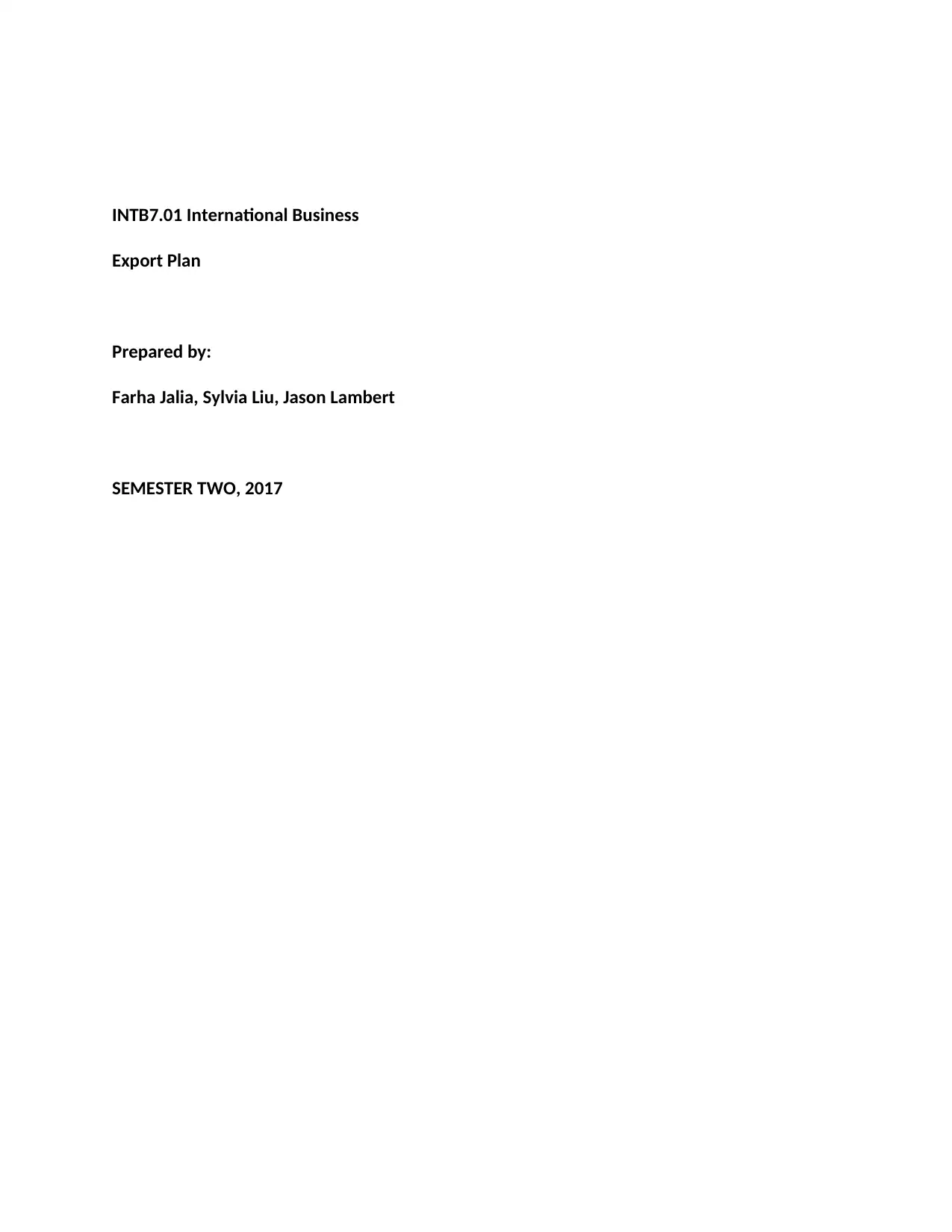
INTB7.01 International Business
Export Plan
Prepared by:
Farha Jalia, Sylvia Liu, Jason Lambert
SEMESTER TWO, 2017
Export Plan
Prepared by:
Farha Jalia, Sylvia Liu, Jason Lambert
SEMESTER TWO, 2017
Paraphrase This Document
Need a fresh take? Get an instant paraphrase of this document with our AI Paraphraser
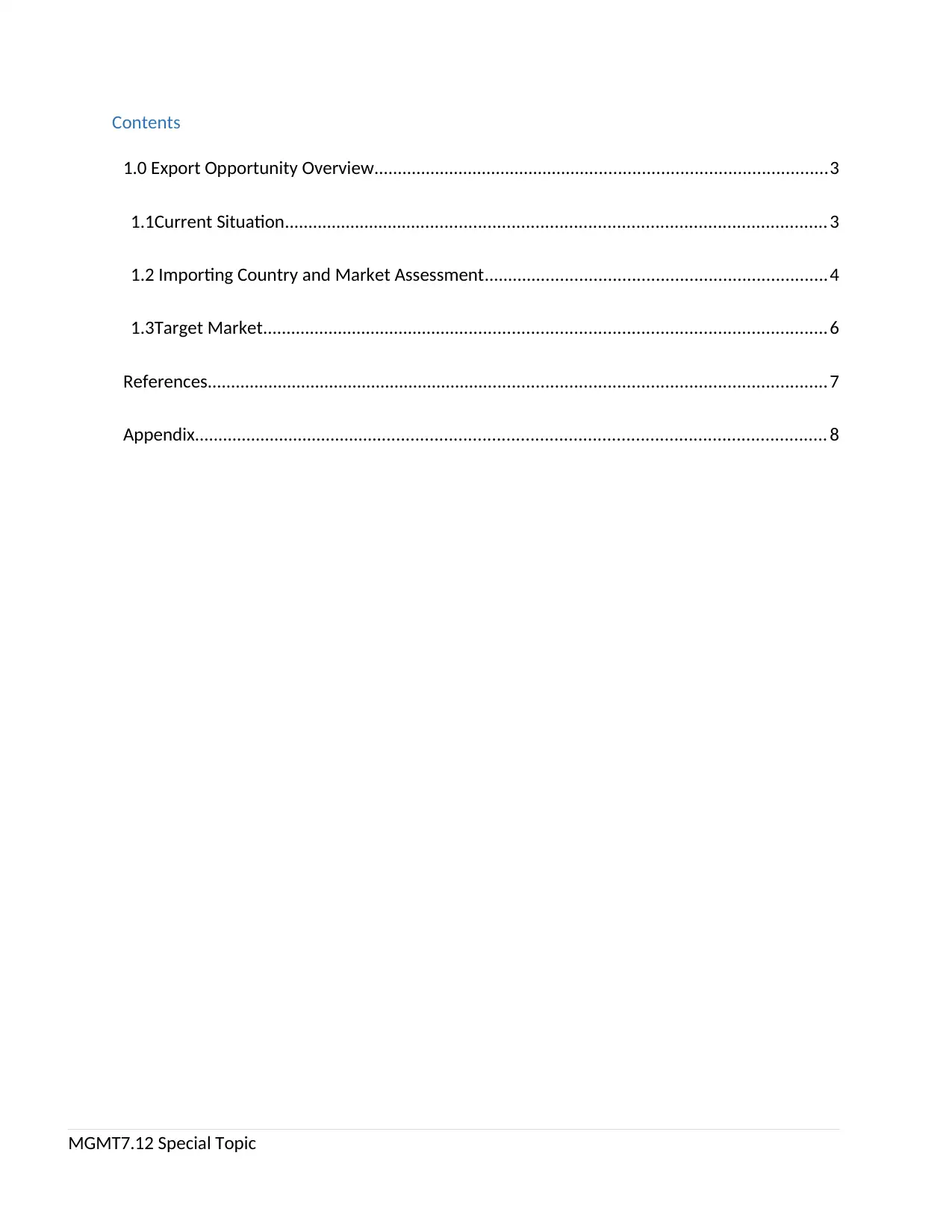
Contents
1.0 Export Opportunity Overview................................................................................................3
1.1Current Situation.................................................................................................................. 3
1.2 Importing Country and Market Assessment........................................................................4
1.3Target Market.......................................................................................................................6
References...................................................................................................................................7
Appendix..................................................................................................................................... 8
MGMT7.12 Special Topic
1.0 Export Opportunity Overview................................................................................................3
1.1Current Situation.................................................................................................................. 3
1.2 Importing Country and Market Assessment........................................................................4
1.3Target Market.......................................................................................................................6
References...................................................................................................................................7
Appendix..................................................................................................................................... 8
MGMT7.12 Special Topic
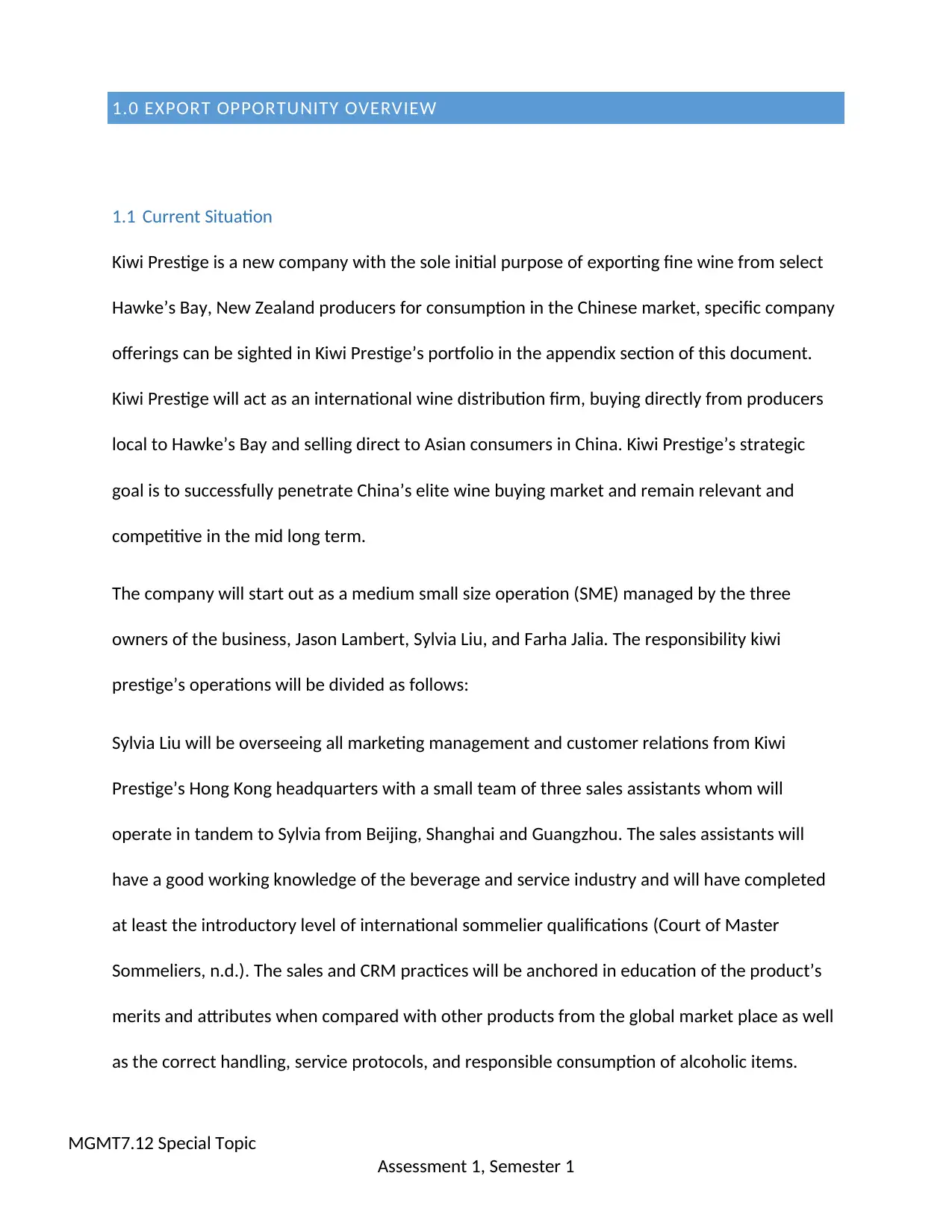
1.0 EXPORT OPPORTUNITY OVERVIEW
1.1 Current Situation
Kiwi Prestige is a new company with the sole initial purpose of exporting fine wine from select
Hawke’s Bay, New Zealand producers for consumption in the Chinese market, specific company
offerings can be sighted in Kiwi Prestige’s portfolio in the appendix section of this document.
Kiwi Prestige will act as an international wine distribution firm, buying directly from producers
local to Hawke’s Bay and selling direct to Asian consumers in China. Kiwi Prestige’s strategic
goal is to successfully penetrate China’s elite wine buying market and remain relevant and
competitive in the mid long term.
The company will start out as a medium small size operation (SME) managed by the three
owners of the business, Jason Lambert, Sylvia Liu, and Farha Jalia. The responsibility kiwi
prestige’s operations will be divided as follows:
Sylvia Liu will be overseeing all marketing management and customer relations from Kiwi
Prestige’s Hong Kong headquarters with a small team of three sales assistants whom will
operate in tandem to Sylvia from Beijing, Shanghai and Guangzhou. The sales assistants will
have a good working knowledge of the beverage and service industry and will have completed
at least the introductory level of international sommelier qualifications (Court of Master
Sommeliers, n.d.). The sales and CRM practices will be anchored in education of the product’s
merits and attributes when compared with other products from the global market place as well
as the correct handling, service protocols, and responsible consumption of alcoholic items.
MGMT7.12 Special Topic
Assessment 1, Semester 1
1.1 Current Situation
Kiwi Prestige is a new company with the sole initial purpose of exporting fine wine from select
Hawke’s Bay, New Zealand producers for consumption in the Chinese market, specific company
offerings can be sighted in Kiwi Prestige’s portfolio in the appendix section of this document.
Kiwi Prestige will act as an international wine distribution firm, buying directly from producers
local to Hawke’s Bay and selling direct to Asian consumers in China. Kiwi Prestige’s strategic
goal is to successfully penetrate China’s elite wine buying market and remain relevant and
competitive in the mid long term.
The company will start out as a medium small size operation (SME) managed by the three
owners of the business, Jason Lambert, Sylvia Liu, and Farha Jalia. The responsibility kiwi
prestige’s operations will be divided as follows:
Sylvia Liu will be overseeing all marketing management and customer relations from Kiwi
Prestige’s Hong Kong headquarters with a small team of three sales assistants whom will
operate in tandem to Sylvia from Beijing, Shanghai and Guangzhou. The sales assistants will
have a good working knowledge of the beverage and service industry and will have completed
at least the introductory level of international sommelier qualifications (Court of Master
Sommeliers, n.d.). The sales and CRM practices will be anchored in education of the product’s
merits and attributes when compared with other products from the global market place as well
as the correct handling, service protocols, and responsible consumption of alcoholic items.
MGMT7.12 Special Topic
Assessment 1, Semester 1
⊘ This is a preview!⊘
Do you want full access?
Subscribe today to unlock all pages.

Trusted by 1+ million students worldwide
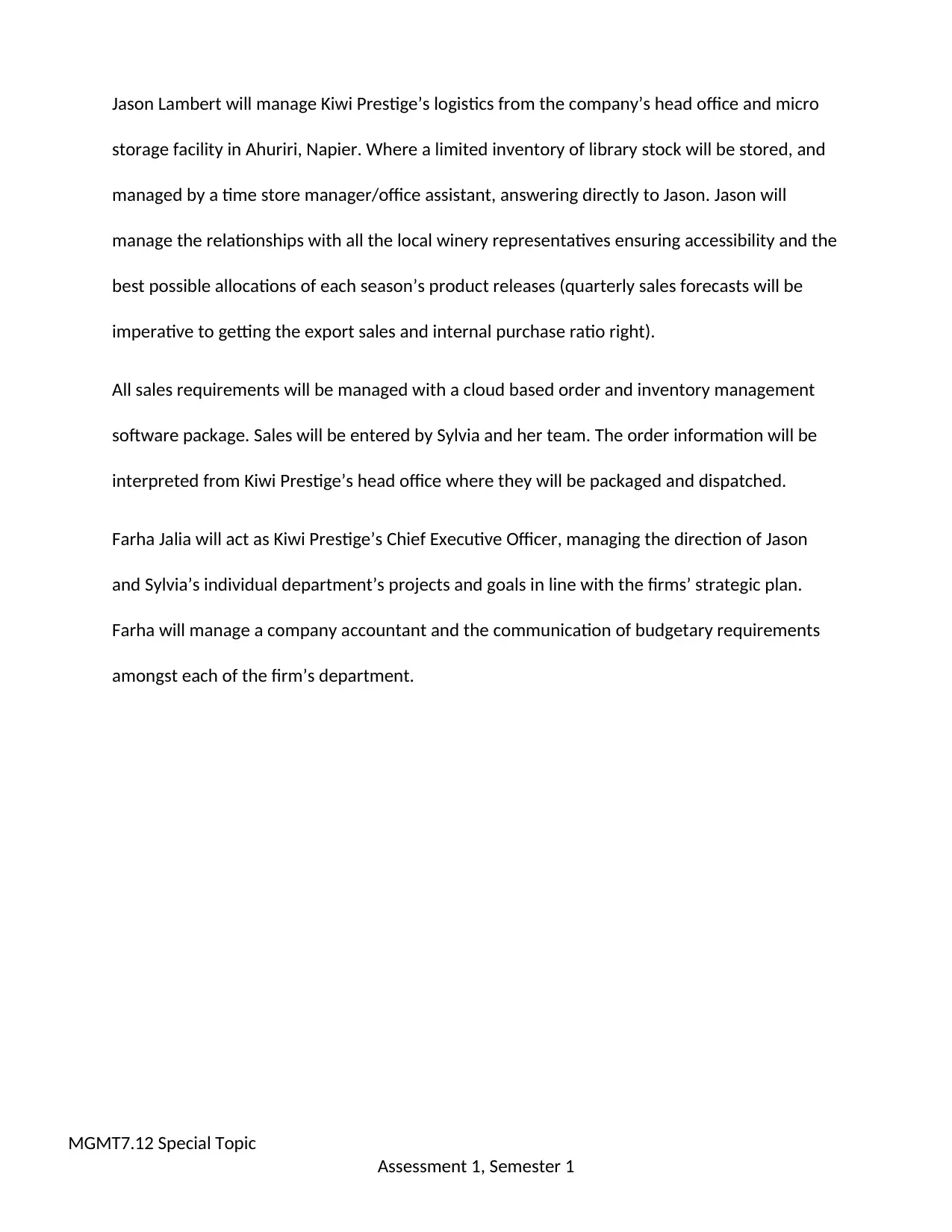
Jason Lambert will manage Kiwi Prestige’s logistics from the company’s head office and micro
storage facility in Ahuriri, Napier. Where a limited inventory of library stock will be stored, and
managed by a time store manager/office assistant, answering directly to Jason. Jason will
manage the relationships with all the local winery representatives ensuring accessibility and the
best possible allocations of each season’s product releases (quarterly sales forecasts will be
imperative to getting the export sales and internal purchase ratio right).
All sales requirements will be managed with a cloud based order and inventory management
software package. Sales will be entered by Sylvia and her team. The order information will be
interpreted from Kiwi Prestige’s head office where they will be packaged and dispatched.
Farha Jalia will act as Kiwi Prestige’s Chief Executive Officer, managing the direction of Jason
and Sylvia’s individual department’s projects and goals in line with the firms’ strategic plan.
Farha will manage a company accountant and the communication of budgetary requirements
amongst each of the firm’s department.
MGMT7.12 Special Topic
Assessment 1, Semester 1
storage facility in Ahuriri, Napier. Where a limited inventory of library stock will be stored, and
managed by a time store manager/office assistant, answering directly to Jason. Jason will
manage the relationships with all the local winery representatives ensuring accessibility and the
best possible allocations of each season’s product releases (quarterly sales forecasts will be
imperative to getting the export sales and internal purchase ratio right).
All sales requirements will be managed with a cloud based order and inventory management
software package. Sales will be entered by Sylvia and her team. The order information will be
interpreted from Kiwi Prestige’s head office where they will be packaged and dispatched.
Farha Jalia will act as Kiwi Prestige’s Chief Executive Officer, managing the direction of Jason
and Sylvia’s individual department’s projects and goals in line with the firms’ strategic plan.
Farha will manage a company accountant and the communication of budgetary requirements
amongst each of the firm’s department.
MGMT7.12 Special Topic
Assessment 1, Semester 1
Paraphrase This Document
Need a fresh take? Get an instant paraphrase of this document with our AI Paraphraser
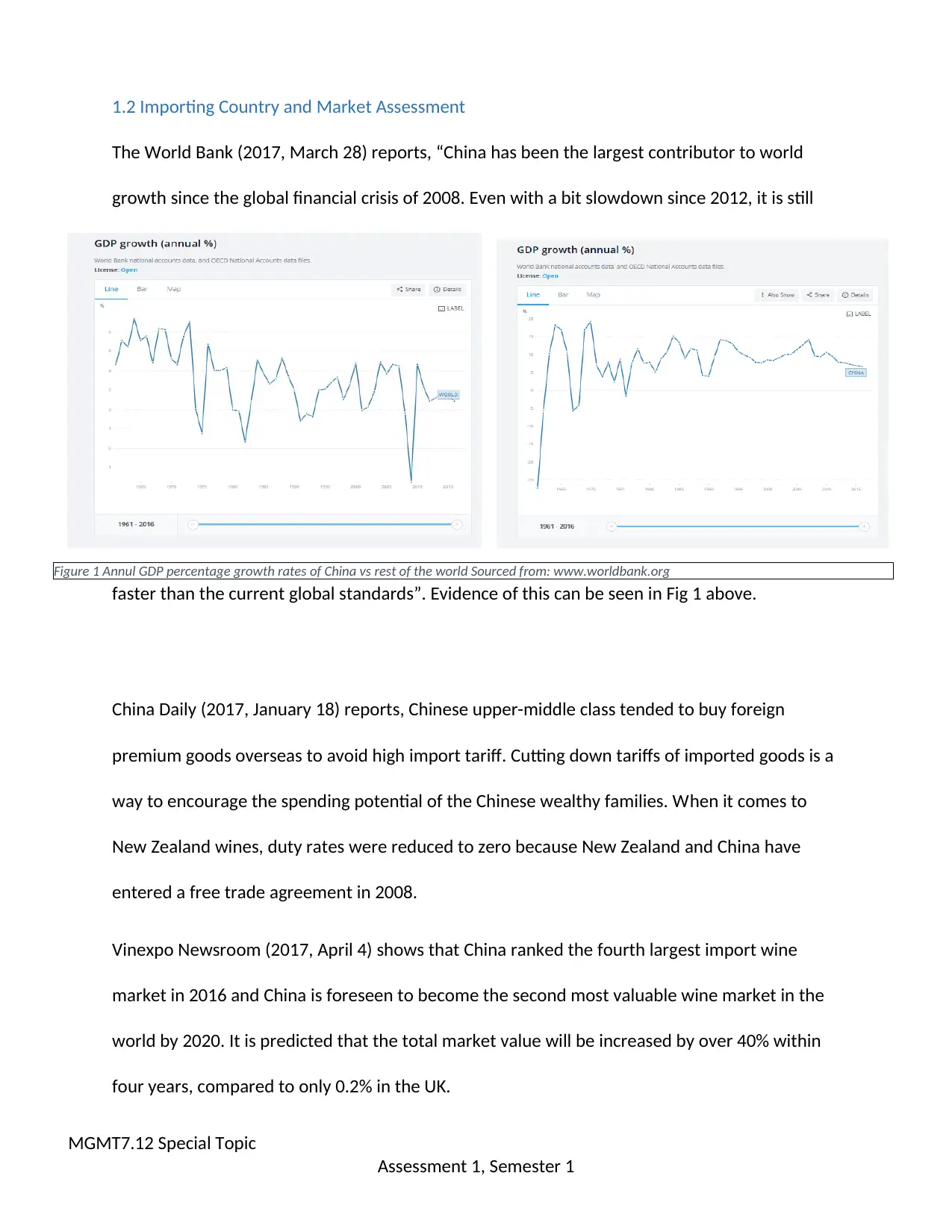
1.2 Importing Country and Market Assessment
The World Bank (2017, March 28) reports, “China has been the largest contributor to world
growth since the global financial crisis of 2008. Even with a bit slowdown since 2012, it is still
faster than the current global standards”. Evidence of this can be seen in Fig 1 above.
China Daily (2017, January 18) reports, Chinese upper-middle class tended to buy foreign
premium goods overseas to avoid high import tariff. Cutting down tariffs of imported goods is a
way to encourage the spending potential of the Chinese wealthy families. When it comes to
New Zealand wines, duty rates were reduced to zero because New Zealand and China have
entered a free trade agreement in 2008.
Vinexpo Newsroom (2017, April 4) shows that China ranked the fourth largest import wine
market in 2016 and China is foreseen to become the second most valuable wine market in the
world by 2020. It is predicted that the total market value will be increased by over 40% within
four years, compared to only 0.2% in the UK.
MGMT7.12 Special Topic
Assessment 1, Semester 1
Figure 1 Annul GDP percentage growth rates of China vs rest of the world Sourced from: www.worldbank.org
The World Bank (2017, March 28) reports, “China has been the largest contributor to world
growth since the global financial crisis of 2008. Even with a bit slowdown since 2012, it is still
faster than the current global standards”. Evidence of this can be seen in Fig 1 above.
China Daily (2017, January 18) reports, Chinese upper-middle class tended to buy foreign
premium goods overseas to avoid high import tariff. Cutting down tariffs of imported goods is a
way to encourage the spending potential of the Chinese wealthy families. When it comes to
New Zealand wines, duty rates were reduced to zero because New Zealand and China have
entered a free trade agreement in 2008.
Vinexpo Newsroom (2017, April 4) shows that China ranked the fourth largest import wine
market in 2016 and China is foreseen to become the second most valuable wine market in the
world by 2020. It is predicted that the total market value will be increased by over 40% within
four years, compared to only 0.2% in the UK.
MGMT7.12 Special Topic
Assessment 1, Semester 1
Figure 1 Annul GDP percentage growth rates of China vs rest of the world Sourced from: www.worldbank.org
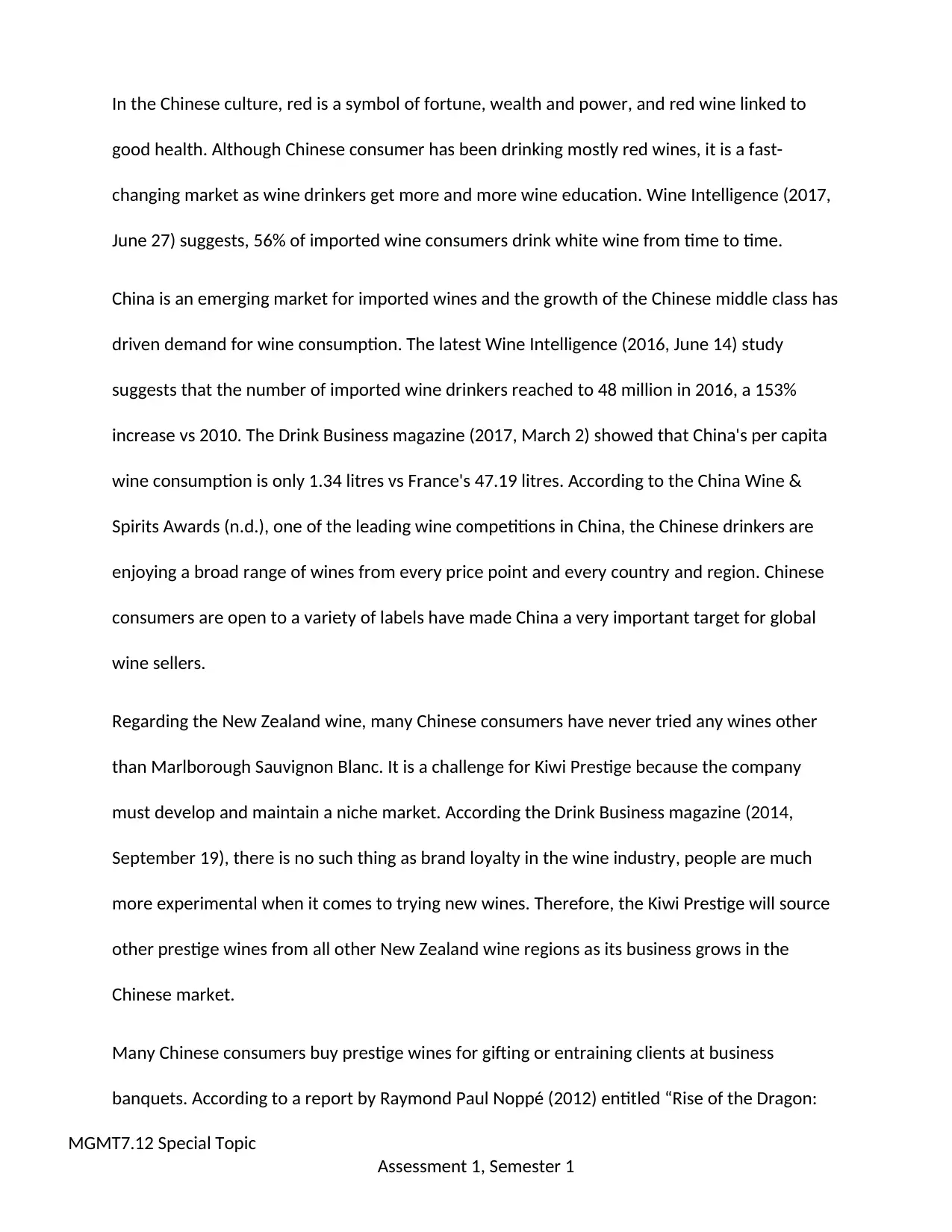
In the Chinese culture, red is a symbol of fortune, wealth and power, and red wine linked to
good health. Although Chinese consumer has been drinking mostly red wines, it is a fast-
changing market as wine drinkers get more and more wine education. Wine Intelligence (2017,
June 27) suggests, 56% of imported wine consumers drink white wine from time to time.
China is an emerging market for imported wines and the growth of the Chinese middle class has
driven demand for wine consumption. The latest Wine Intelligence (2016, June 14) study
suggests that the number of imported wine drinkers reached to 48 million in 2016, a 153%
increase vs 2010. The Drink Business magazine (2017, March 2) showed that China's per capita
wine consumption is only 1.34 litres vs France's 47.19 litres. According to the China Wine &
Spirits Awards (n.d.), one of the leading wine competitions in China, the Chinese drinkers are
enjoying a broad range of wines from every price point and every country and region. Chinese
consumers are open to a variety of labels have made China a very important target for global
wine sellers.
Regarding the New Zealand wine, many Chinese consumers have never tried any wines other
than Marlborough Sauvignon Blanc. It is a challenge for Kiwi Prestige because the company
must develop and maintain a niche market. According the Drink Business magazine (2014,
September 19), there is no such thing as brand loyalty in the wine industry, people are much
more experimental when it comes to trying new wines. Therefore, the Kiwi Prestige will source
other prestige wines from all other New Zealand wine regions as its business grows in the
Chinese market.
Many Chinese consumers buy prestige wines for gifting or entraining clients at business
banquets. According to a report by Raymond Paul Noppé (2012) entitled “Rise of the Dragon:
MGMT7.12 Special Topic
Assessment 1, Semester 1
good health. Although Chinese consumer has been drinking mostly red wines, it is a fast-
changing market as wine drinkers get more and more wine education. Wine Intelligence (2017,
June 27) suggests, 56% of imported wine consumers drink white wine from time to time.
China is an emerging market for imported wines and the growth of the Chinese middle class has
driven demand for wine consumption. The latest Wine Intelligence (2016, June 14) study
suggests that the number of imported wine drinkers reached to 48 million in 2016, a 153%
increase vs 2010. The Drink Business magazine (2017, March 2) showed that China's per capita
wine consumption is only 1.34 litres vs France's 47.19 litres. According to the China Wine &
Spirits Awards (n.d.), one of the leading wine competitions in China, the Chinese drinkers are
enjoying a broad range of wines from every price point and every country and region. Chinese
consumers are open to a variety of labels have made China a very important target for global
wine sellers.
Regarding the New Zealand wine, many Chinese consumers have never tried any wines other
than Marlborough Sauvignon Blanc. It is a challenge for Kiwi Prestige because the company
must develop and maintain a niche market. According the Drink Business magazine (2014,
September 19), there is no such thing as brand loyalty in the wine industry, people are much
more experimental when it comes to trying new wines. Therefore, the Kiwi Prestige will source
other prestige wines from all other New Zealand wine regions as its business grows in the
Chinese market.
Many Chinese consumers buy prestige wines for gifting or entraining clients at business
banquets. According to a report by Raymond Paul Noppé (2012) entitled “Rise of the Dragon:
MGMT7.12 Special Topic
Assessment 1, Semester 1
⊘ This is a preview!⊘
Do you want full access?
Subscribe today to unlock all pages.

Trusted by 1+ million students worldwide
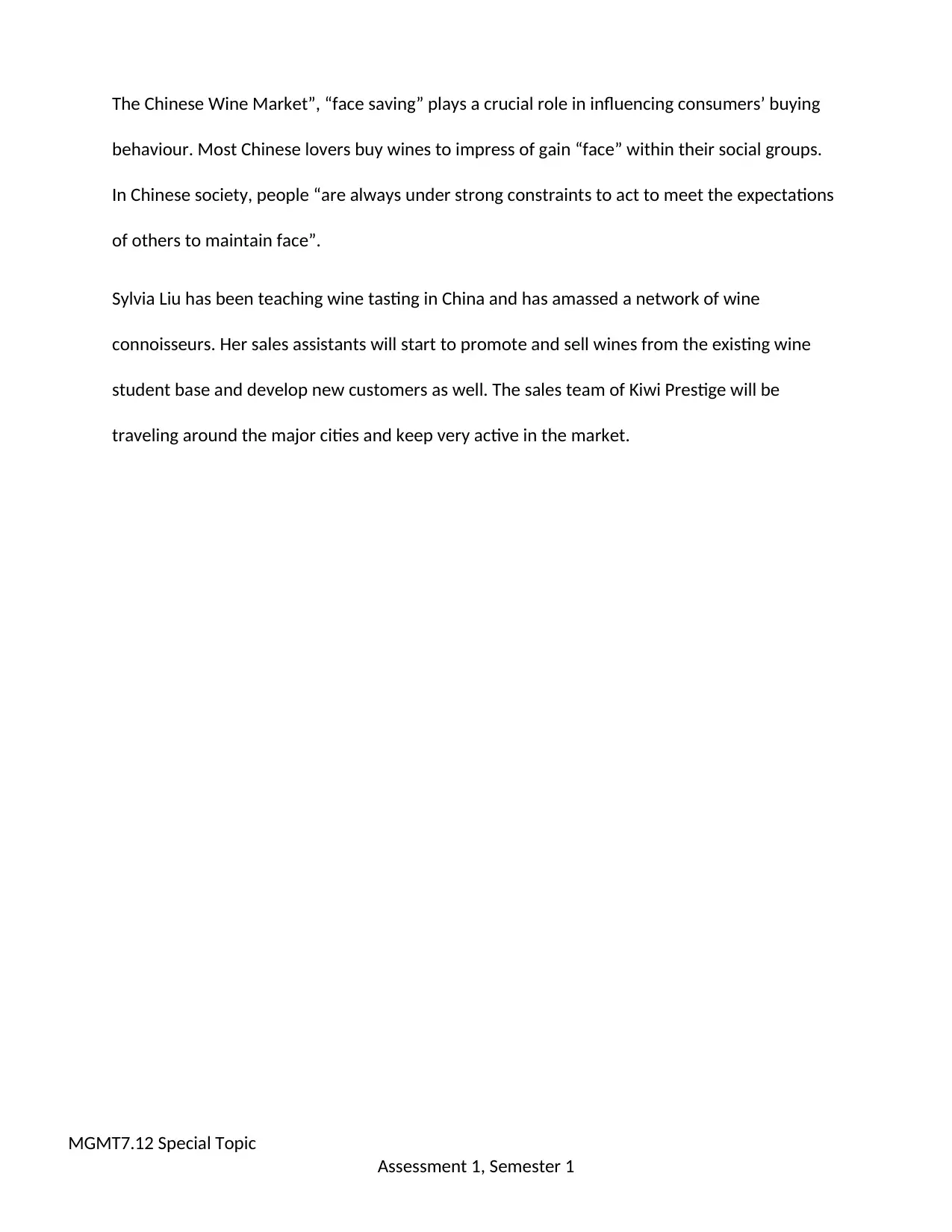
The Chinese Wine Market”, “face saving” plays a crucial role in influencing consumers’ buying
behaviour. Most Chinese lovers buy wines to impress of gain “face” within their social groups.
In Chinese society, people “are always under strong constraints to act to meet the expectations
of others to maintain face”.
Sylvia Liu has been teaching wine tasting in China and has amassed a network of wine
connoisseurs. Her sales assistants will start to promote and sell wines from the existing wine
student base and develop new customers as well. The sales team of Kiwi Prestige will be
traveling around the major cities and keep very active in the market.
MGMT7.12 Special Topic
Assessment 1, Semester 1
behaviour. Most Chinese lovers buy wines to impress of gain “face” within their social groups.
In Chinese society, people “are always under strong constraints to act to meet the expectations
of others to maintain face”.
Sylvia Liu has been teaching wine tasting in China and has amassed a network of wine
connoisseurs. Her sales assistants will start to promote and sell wines from the existing wine
student base and develop new customers as well. The sales team of Kiwi Prestige will be
traveling around the major cities and keep very active in the market.
MGMT7.12 Special Topic
Assessment 1, Semester 1
Paraphrase This Document
Need a fresh take? Get an instant paraphrase of this document with our AI Paraphraser
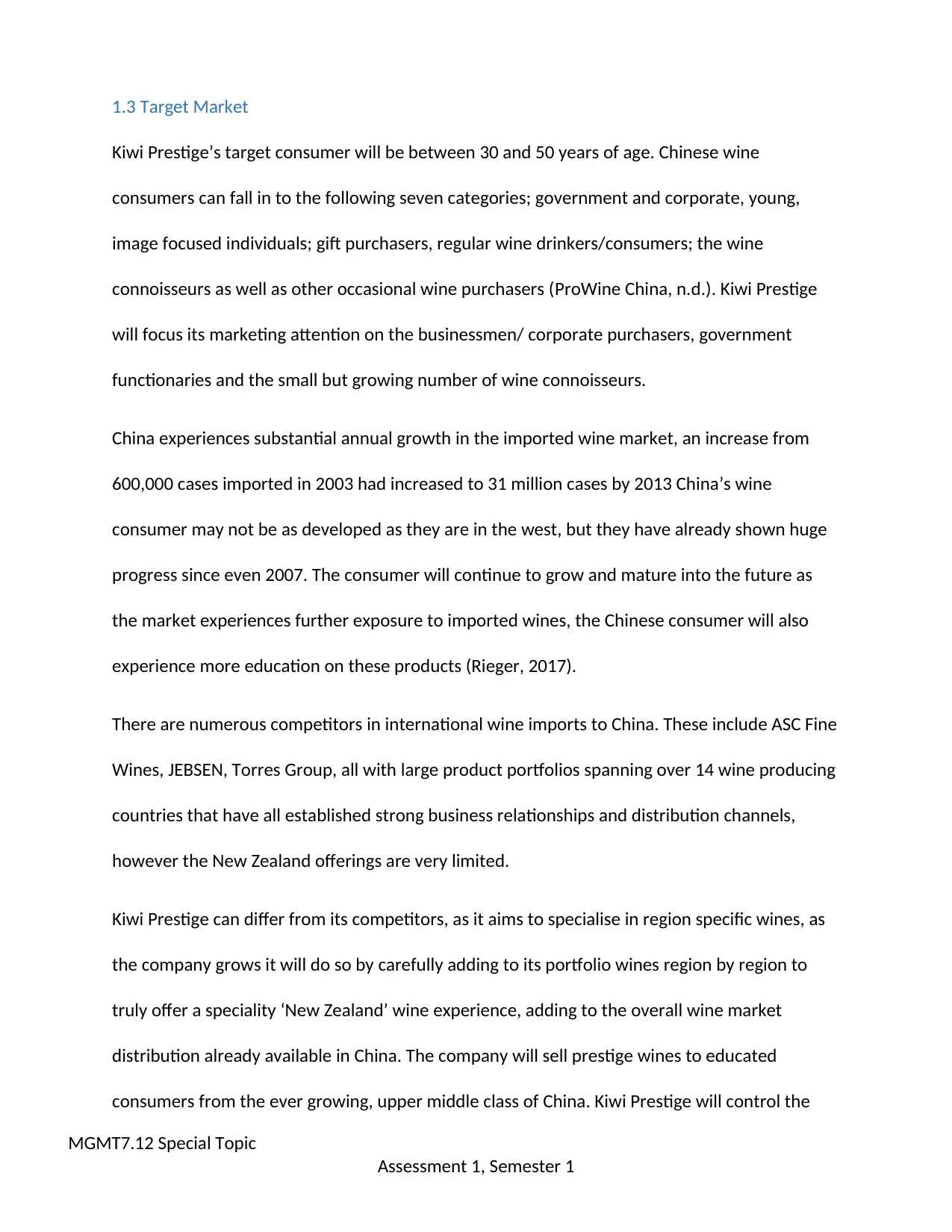
1.3 Target Market
Kiwi Prestige’s target consumer will be between 30 and 50 years of age. Chinese wine
consumers can fall in to the following seven categories; government and corporate, young,
image focused individuals; gift purchasers, regular wine drinkers/consumers; the wine
connoisseurs as well as other occasional wine purchasers (ProWine China, n.d.). Kiwi Prestige
will focus its marketing attention on the businessmen/ corporate purchasers, government
functionaries and the small but growing number of wine connoisseurs.
China experiences substantial annual growth in the imported wine market, an increase from
600,000 cases imported in 2003 had increased to 31 million cases by 2013 China’s wine
consumer may not be as developed as they are in the west, but they have already shown huge
progress since even 2007. The consumer will continue to grow and mature into the future as
the market experiences further exposure to imported wines, the Chinese consumer will also
experience more education on these products (Rieger, 2017).
There are numerous competitors in international wine imports to China. These include ASC Fine
Wines, JEBSEN, Torres Group, all with large product portfolios spanning over 14 wine producing
countries that have all established strong business relationships and distribution channels,
however the New Zealand offerings are very limited.
Kiwi Prestige can differ from its competitors, as it aims to specialise in region specific wines, as
the company grows it will do so by carefully adding to its portfolio wines region by region to
truly offer a speciality ‘New Zealand’ wine experience, adding to the overall wine market
distribution already available in China. The company will sell prestige wines to educated
consumers from the ever growing, upper middle class of China. Kiwi Prestige will control the
MGMT7.12 Special Topic
Assessment 1, Semester 1
Kiwi Prestige’s target consumer will be between 30 and 50 years of age. Chinese wine
consumers can fall in to the following seven categories; government and corporate, young,
image focused individuals; gift purchasers, regular wine drinkers/consumers; the wine
connoisseurs as well as other occasional wine purchasers (ProWine China, n.d.). Kiwi Prestige
will focus its marketing attention on the businessmen/ corporate purchasers, government
functionaries and the small but growing number of wine connoisseurs.
China experiences substantial annual growth in the imported wine market, an increase from
600,000 cases imported in 2003 had increased to 31 million cases by 2013 China’s wine
consumer may not be as developed as they are in the west, but they have already shown huge
progress since even 2007. The consumer will continue to grow and mature into the future as
the market experiences further exposure to imported wines, the Chinese consumer will also
experience more education on these products (Rieger, 2017).
There are numerous competitors in international wine imports to China. These include ASC Fine
Wines, JEBSEN, Torres Group, all with large product portfolios spanning over 14 wine producing
countries that have all established strong business relationships and distribution channels,
however the New Zealand offerings are very limited.
Kiwi Prestige can differ from its competitors, as it aims to specialise in region specific wines, as
the company grows it will do so by carefully adding to its portfolio wines region by region to
truly offer a speciality ‘New Zealand’ wine experience, adding to the overall wine market
distribution already available in China. The company will sell prestige wines to educated
consumers from the ever growing, upper middle class of China. Kiwi Prestige will control the
MGMT7.12 Special Topic
Assessment 1, Semester 1
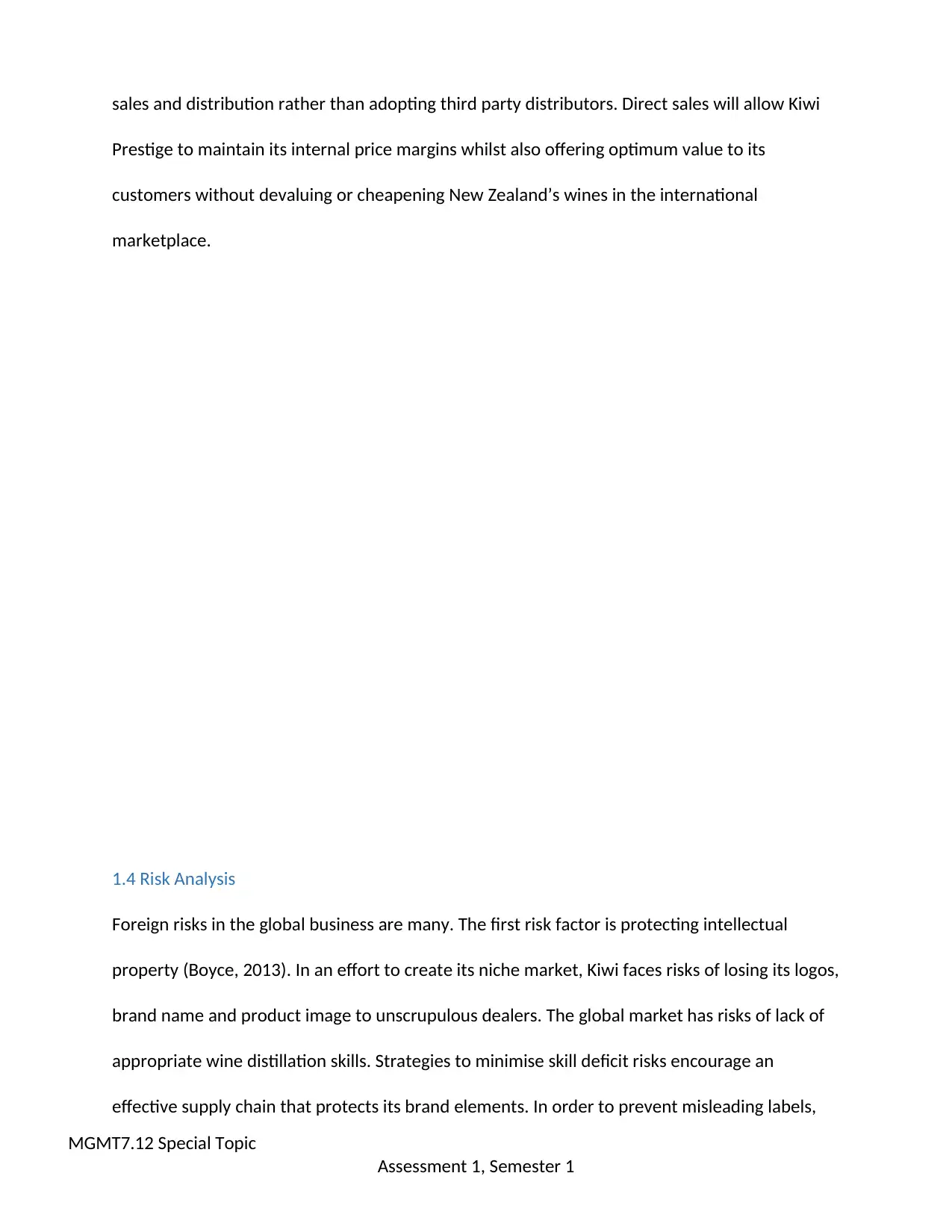
sales and distribution rather than adopting third party distributors. Direct sales will allow Kiwi
Prestige to maintain its internal price margins whilst also offering optimum value to its
customers without devaluing or cheapening New Zealand’s wines in the international
marketplace.
1.4 Risk Analysis
Foreign risks in the global business are many. The first risk factor is protecting intellectual
property (Boyce, 2013). In an effort to create its niche market, Kiwi faces risks of losing its logos,
brand name and product image to unscrupulous dealers. The global market has risks of lack of
appropriate wine distillation skills. Strategies to minimise skill deficit risks encourage an
effective supply chain that protects its brand elements. In order to prevent misleading labels,
MGMT7.12 Special Topic
Assessment 1, Semester 1
Prestige to maintain its internal price margins whilst also offering optimum value to its
customers without devaluing or cheapening New Zealand’s wines in the international
marketplace.
1.4 Risk Analysis
Foreign risks in the global business are many. The first risk factor is protecting intellectual
property (Boyce, 2013). In an effort to create its niche market, Kiwi faces risks of losing its logos,
brand name and product image to unscrupulous dealers. The global market has risks of lack of
appropriate wine distillation skills. Strategies to minimise skill deficit risks encourage an
effective supply chain that protects its brand elements. In order to prevent misleading labels,
MGMT7.12 Special Topic
Assessment 1, Semester 1
⊘ This is a preview!⊘
Do you want full access?
Subscribe today to unlock all pages.

Trusted by 1+ million students worldwide
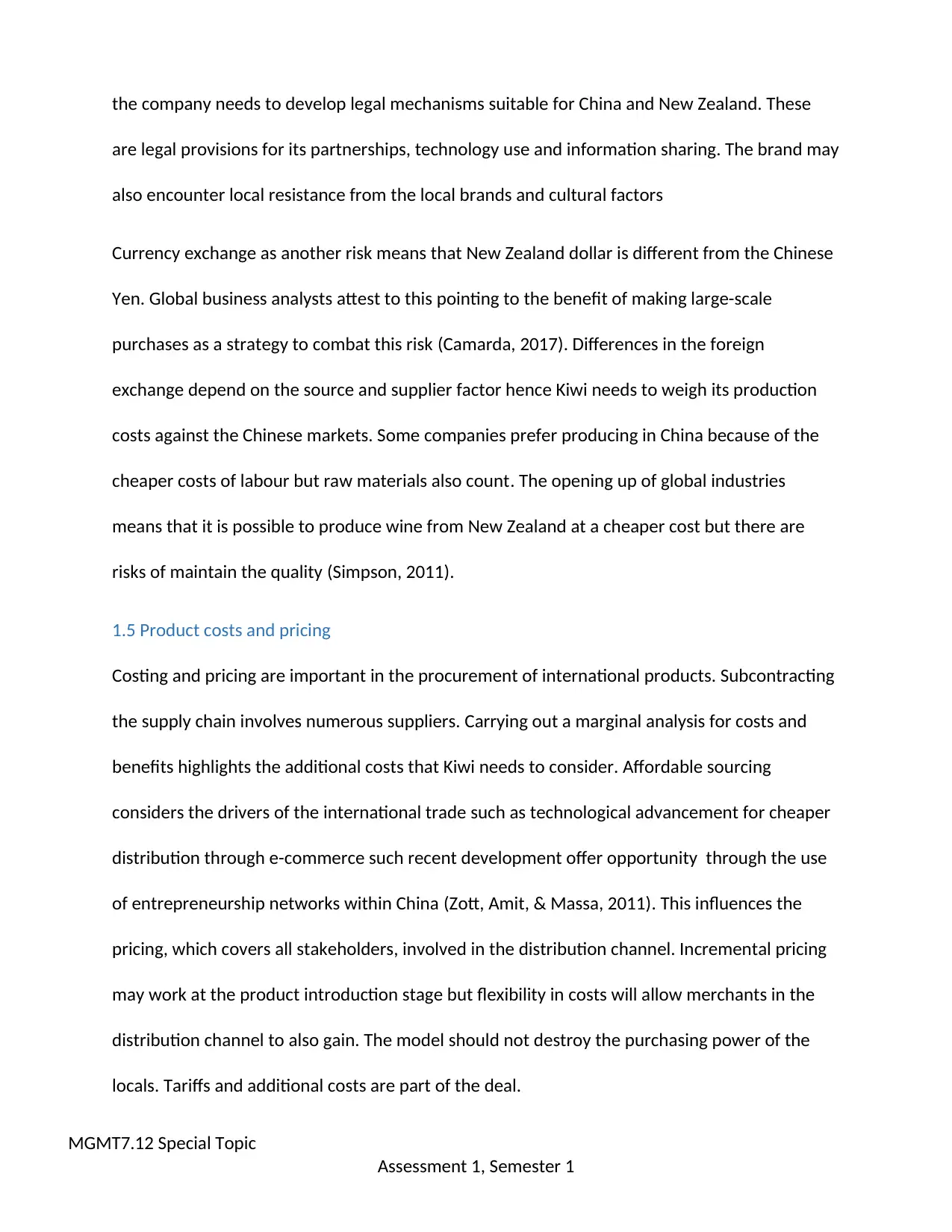
the company needs to develop legal mechanisms suitable for China and New Zealand. These
are legal provisions for its partnerships, technology use and information sharing. The brand may
also encounter local resistance from the local brands and cultural factors
Currency exchange as another risk means that New Zealand dollar is different from the Chinese
Yen. Global business analysts attest to this pointing to the benefit of making large-scale
purchases as a strategy to combat this risk (Camarda, 2017). Differences in the foreign
exchange depend on the source and supplier factor hence Kiwi needs to weigh its production
costs against the Chinese markets. Some companies prefer producing in China because of the
cheaper costs of labour but raw materials also count. The opening up of global industries
means that it is possible to produce wine from New Zealand at a cheaper cost but there are
risks of maintain the quality (Simpson, 2011).
1.5 Product costs and pricing
Costing and pricing are important in the procurement of international products. Subcontracting
the supply chain involves numerous suppliers. Carrying out a marginal analysis for costs and
benefits highlights the additional costs that Kiwi needs to consider. Affordable sourcing
considers the drivers of the international trade such as technological advancement for cheaper
distribution through e-commerce such recent development offer opportunity through the use
of entrepreneurship networks within China (Zott, Amit, & Massa, 2011). This influences the
pricing, which covers all stakeholders, involved in the distribution channel. Incremental pricing
may work at the product introduction stage but flexibility in costs will allow merchants in the
distribution channel to also gain. The model should not destroy the purchasing power of the
locals. Tariffs and additional costs are part of the deal.
MGMT7.12 Special Topic
Assessment 1, Semester 1
are legal provisions for its partnerships, technology use and information sharing. The brand may
also encounter local resistance from the local brands and cultural factors
Currency exchange as another risk means that New Zealand dollar is different from the Chinese
Yen. Global business analysts attest to this pointing to the benefit of making large-scale
purchases as a strategy to combat this risk (Camarda, 2017). Differences in the foreign
exchange depend on the source and supplier factor hence Kiwi needs to weigh its production
costs against the Chinese markets. Some companies prefer producing in China because of the
cheaper costs of labour but raw materials also count. The opening up of global industries
means that it is possible to produce wine from New Zealand at a cheaper cost but there are
risks of maintain the quality (Simpson, 2011).
1.5 Product costs and pricing
Costing and pricing are important in the procurement of international products. Subcontracting
the supply chain involves numerous suppliers. Carrying out a marginal analysis for costs and
benefits highlights the additional costs that Kiwi needs to consider. Affordable sourcing
considers the drivers of the international trade such as technological advancement for cheaper
distribution through e-commerce such recent development offer opportunity through the use
of entrepreneurship networks within China (Zott, Amit, & Massa, 2011). This influences the
pricing, which covers all stakeholders, involved in the distribution channel. Incremental pricing
may work at the product introduction stage but flexibility in costs will allow merchants in the
distribution channel to also gain. The model should not destroy the purchasing power of the
locals. Tariffs and additional costs are part of the deal.
MGMT7.12 Special Topic
Assessment 1, Semester 1
Paraphrase This Document
Need a fresh take? Get an instant paraphrase of this document with our AI Paraphraser
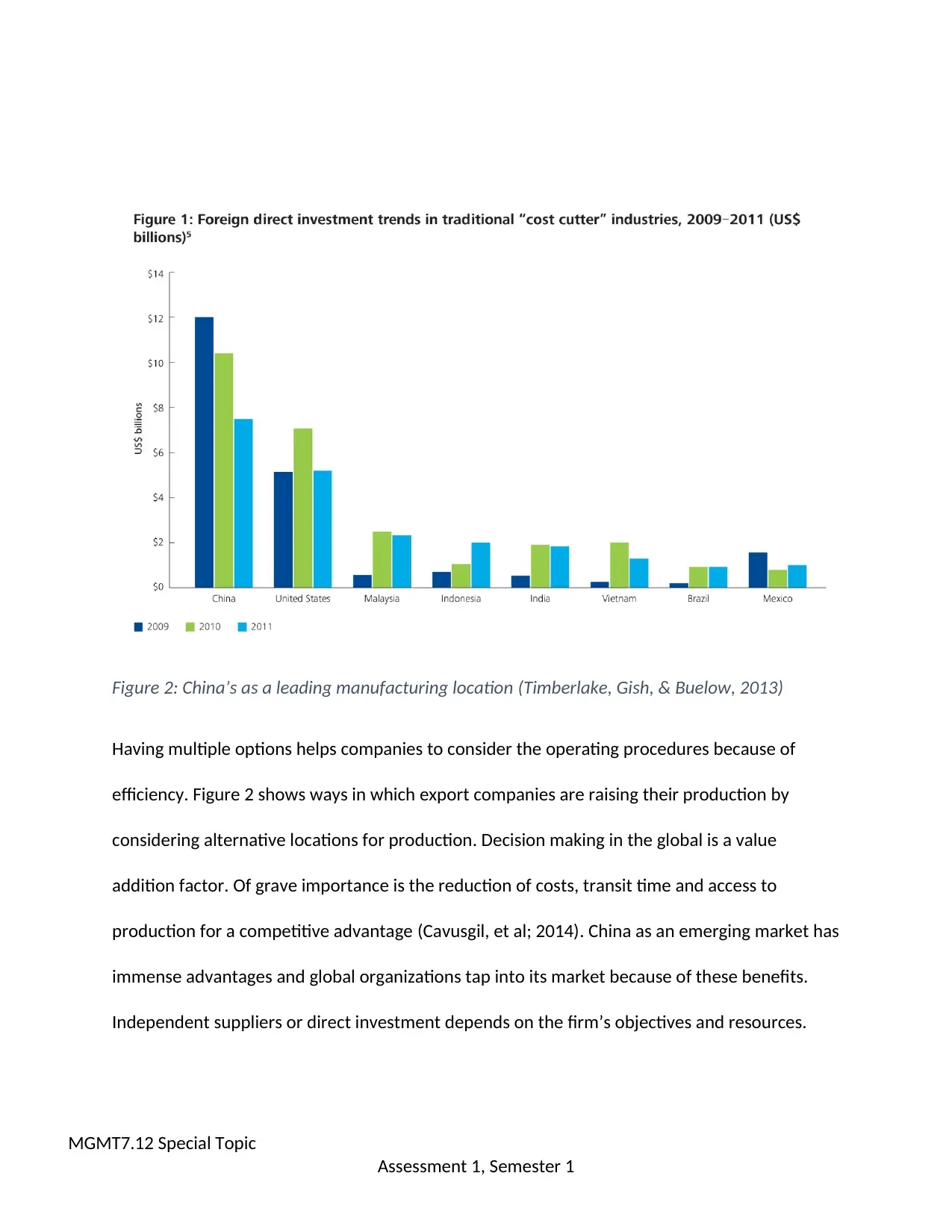
Figure 2: China’s as a leading manufacturing location (Timberlake, Gish, & Buelow, 2013)
Having multiple options helps companies to consider the operating procedures because of
efficiency. Figure 2 shows ways in which export companies are raising their production by
considering alternative locations for production. Decision making in the global is a value
addition factor. Of grave importance is the reduction of costs, transit time and access to
production for a competitive advantage (Cavusgil, et al; 2014). China as an emerging market has
immense advantages and global organizations tap into its market because of these benefits.
Independent suppliers or direct investment depends on the firm’s objectives and resources.
MGMT7.12 Special Topic
Assessment 1, Semester 1
Having multiple options helps companies to consider the operating procedures because of
efficiency. Figure 2 shows ways in which export companies are raising their production by
considering alternative locations for production. Decision making in the global is a value
addition factor. Of grave importance is the reduction of costs, transit time and access to
production for a competitive advantage (Cavusgil, et al; 2014). China as an emerging market has
immense advantages and global organizations tap into its market because of these benefits.
Independent suppliers or direct investment depends on the firm’s objectives and resources.
MGMT7.12 Special Topic
Assessment 1, Semester 1
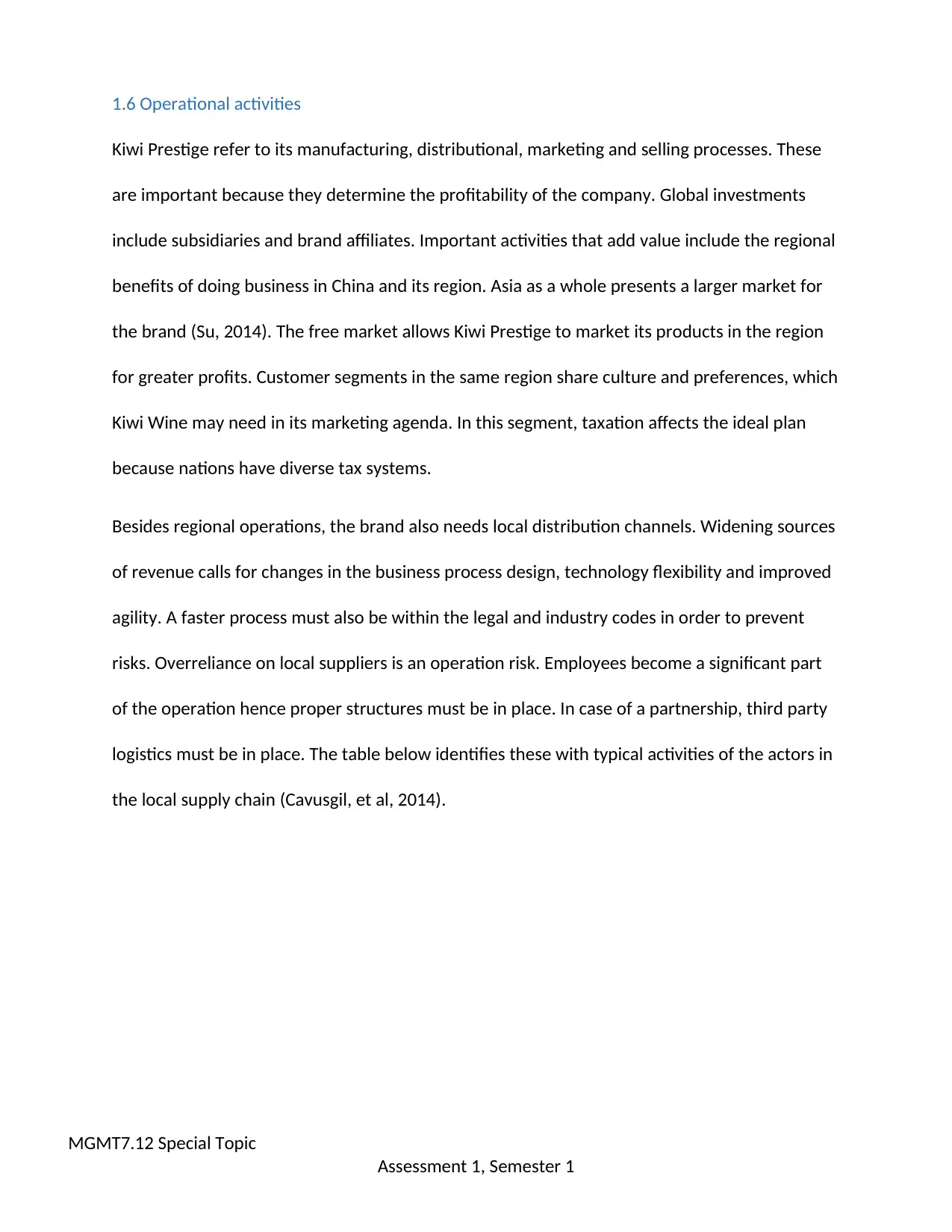
1.6 Operational activities
Kiwi Prestige refer to its manufacturing, distributional, marketing and selling processes. These
are important because they determine the profitability of the company. Global investments
include subsidiaries and brand affiliates. Important activities that add value include the regional
benefits of doing business in China and its region. Asia as a whole presents a larger market for
the brand (Su, 2014). The free market allows Kiwi Prestige to market its products in the region
for greater profits. Customer segments in the same region share culture and preferences, which
Kiwi Wine may need in its marketing agenda. In this segment, taxation affects the ideal plan
because nations have diverse tax systems.
Besides regional operations, the brand also needs local distribution channels. Widening sources
of revenue calls for changes in the business process design, technology flexibility and improved
agility. A faster process must also be within the legal and industry codes in order to prevent
risks. Overreliance on local suppliers is an operation risk. Employees become a significant part
of the operation hence proper structures must be in place. In case of a partnership, third party
logistics must be in place. The table below identifies these with typical activities of the actors in
the local supply chain (Cavusgil, et al, 2014).
MGMT7.12 Special Topic
Assessment 1, Semester 1
Kiwi Prestige refer to its manufacturing, distributional, marketing and selling processes. These
are important because they determine the profitability of the company. Global investments
include subsidiaries and brand affiliates. Important activities that add value include the regional
benefits of doing business in China and its region. Asia as a whole presents a larger market for
the brand (Su, 2014). The free market allows Kiwi Prestige to market its products in the region
for greater profits. Customer segments in the same region share culture and preferences, which
Kiwi Wine may need in its marketing agenda. In this segment, taxation affects the ideal plan
because nations have diverse tax systems.
Besides regional operations, the brand also needs local distribution channels. Widening sources
of revenue calls for changes in the business process design, technology flexibility and improved
agility. A faster process must also be within the legal and industry codes in order to prevent
risks. Overreliance on local suppliers is an operation risk. Employees become a significant part
of the operation hence proper structures must be in place. In case of a partnership, third party
logistics must be in place. The table below identifies these with typical activities of the actors in
the local supply chain (Cavusgil, et al, 2014).
MGMT7.12 Special Topic
Assessment 1, Semester 1
⊘ This is a preview!⊘
Do you want full access?
Subscribe today to unlock all pages.

Trusted by 1+ million students worldwide
1 out of 20
Your All-in-One AI-Powered Toolkit for Academic Success.
+13062052269
info@desklib.com
Available 24*7 on WhatsApp / Email
![[object Object]](/_next/static/media/star-bottom.7253800d.svg)
Unlock your academic potential
Copyright © 2020–2025 A2Z Services. All Rights Reserved. Developed and managed by ZUCOL.